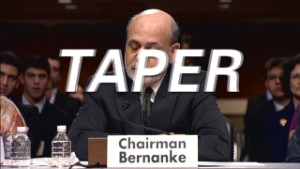Thanks to RBI and FM,
the specter of imminent fed taper couldn’t haunt markets as it did back in May.
In
what served as a nightmare for Indian economy back in May, when turned real was
treated as a business as usual. The much discussed and feared US dollar
tapering by Federal Reserve, first announcement of which shook the cores of
rupee is finally set to begin from New Year. Dollar inflows are to be narrowed down in the
markets but thanks to the improved level of Current Account Deficit, the
difference between outflow and inflow of the foreign exchange, rupee wouldn’t
lose its stand against dollar.
US Federal Reserve
Chief Ben Bernanke on Thursday announced to cut down on its monthly dollar
minting program by $10bn, bringing it to $75bn dollar. Fed, with an effort to
spur growth, had been pumping in cheap money to the tune of $85bn in its
economy on monthly basis which in turn also benefitted emerging market
economies wherein US investors parked that cheaply acquired money for better
returns. India was one of the beneficiaries of this program. However, Fed Chief
announced to taper off liquidating dollars in May 2013. Mere his words were
enough to scare the investors though final decision was yet to be taken.
Foreign Institutional Investment (FIIs) began flocking out depreciating rupee’s
value against dollar, which touched its all time low in August at Rs. 68.85 per
dollar. It is only after drastic measures taken by Reserve Bank of India and Finance
Ministry to attract dollars and cut down on imports that rupee could be
strengthened.
In this background,
it is surprising that panic-stricken response shown by markets back then didn’t
come to pass now, now when taper is certain and just round the corner. To
compare the current scenario from May, India is better placed at all fronts.
First, the time and pace of taper was uncertain then which is not only clear
but bearable at $10bn reduction a month. Secondly, India’s foreign reserve and
CAD have improved a lot. The unprecedented surge in gold imports of earlier
times could be controlled including few other non essential and expensive
imports. CAD narrowed sharply to $5.2 billion, or 1.2 per cent of GDP, in the
July-September quarter of 2013-14 which hovered around 4-5% in the previous
quarters. In addition, RBI’s move taken in Sep 2013 to ease it for banks to run
Foreign Currency Non-residents (banks) deposit scheme has also played out well.
Under FCNR (B) scheme NRIs do not face currency risk; the currency risk is
borne by banks. RBI had helped banks reduce this risk so that they attract more
of NRIs to make use of this scheme and don’t stay away from offering it in the
tight domestic currency scenario.
These measures apart
from turnaround in exports have made Indian economy resilient enough to face
imminent outflows of dollars. Initially rupee might lose traction against
dollar but that wouldn’t be severe and wouldn’t sustain for long. Considering
US economy is back on growth trajectory, fed taper can instead be positive for
India in a sense that demand boost in US will drive export growth of Indian
export enterprises having business in US. That is double dose good news for
them as lately they are already reaping benefits of surge in exports.
The specter of Fed
Reserve taper is no more there to haunt. India’s external front is under
control for now. It is time that all efforts are put to reduce notoriously high
inflation, the pivot of economic growth cycle and thus boost industrial
production bringing jobs and growth in the country.









